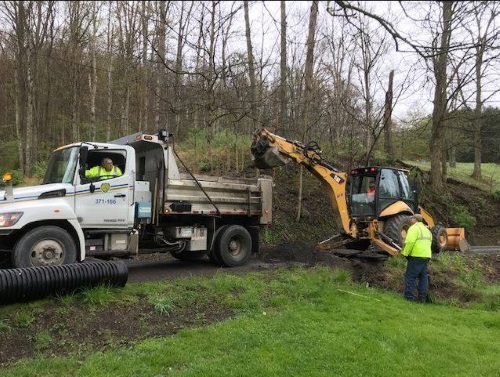Breaking Down State DOT COVID-19 Relief Funding

The American Association of State Highway and Transportation Officials recently analyzed the $10 billion in emergency aid provided to state departments of transportation as part of the $900 billion COVID-19 relief measure signed into law on December 27 along with the appropriations package for all of fiscal year 2021.
[Above photo by the West Virginia DOT.]
That analysis – conducted by AASHTO’s transportation policy team – noted that of the $10 billion in direct funding assistance for COVID-19 relief for state DOTs, $9.8 billion will be distributed through the Surface Transportation Block Grant Program or STBGP, with the remaining $200 million going to territories, tribes, and Puerto Rico’s transportation programs.
[For a synopsis of that year-end legislative package, click here.]
In addition to traditional construction activities eligible under STBGP, AASHTO’s analysis indicated COVID-19 relief funding provides “extraordinary flexibility,” allowing that funding to cover preventive maintenance, routine maintenance, operations, and personnel costs – including employee salaries. That funding flexibility also covers debt service payments, availability payments, and coverage for other revenue losses, the group said.

AASHTO added that states must wait on an FHWA ruling to clarify what language such as “revenue loss” entails for reporting purposes. “Specificity of submitted expenses, both capital and non-capital, will probably facilitate the approval process,” the group noted in its analysis.
AASHTO added that FHWA has not released guidelines yet regarding whether states can be reimbursed for previously incurred costs. However, “existing language does not necessarily preclude such a reimbursement for prior expenses,” the group said, though some CARES Act language maintained that dollars were for expenses incurred no earlier than January 2020.
In addition to the COVID-19 relief measure, the $1.4 trillion omnibus funding package for FY 2021 included an additional $2 billion from the federal government’s general fund for the Federal-aid Highway Program above the baseline established by the Fixing America’s Surface Transportation or FAST Act. Of that $2 billion supplement, about $1 billion will be directed to a bridge rehabilitation program with another $700 million distributed via STBGP eligibilities, AASHTO said.
In terms of the COVID-19 relief aid, state DOTs will receive funds based on each state’s share of the FY 2021 FAST Act obligation limitation. The Federal Highway Administration has 30 days from the time the bill became law – in this case December 27, 2020 – to distribute those funds.
[To view estimated state-by-state apportionments of COVID-19 emergency funding, click here.]
“The $9.8 billion in direct aid to state DOTs are to be made available through September 2024 as a standalone pot, directed under appropriated budget authority from the general fund rather than contract authority from the Highway Trust Fund,” AASHTO noted in its analysis. “The FHWA has yet to release the full year 2021 obligation limitation which would determine each state’s share of COVID relief funds, but will hopefully do so sometime in January.”
AASHTO also noted that, of the $9.8 billion to state DOTs, about 14 percent of the nationwide total will be sub-allocated, but only to Transportation Management Areas or urbanized areas of at least 200,000 people. The sub-allocation percentage will vary significantly from state to state.
Another eligibility serves toll agencies and ferry operators specifically – reflecting funding requests from those sectors rolled into the state DOT fund.
Finally – due to the ongoing economic impacts of the COVID-19 pandemic – AASHTO anticipates the need for further relief funding by state and local governments to continue to be a “top issue” for congress in the first half of 2021.
“Since the early response to the pandemic, state DOTs have faced severe losses in state transportation revenues as vehicle travel declined,” explained Jim Tymon, AASHTO’s executive director, in a December 2020 statement.
“This COVID relief bill enables state DOTs to stay on track and support the efficient movement of critical goods and services as they maintain their transportation systems,” he said.


